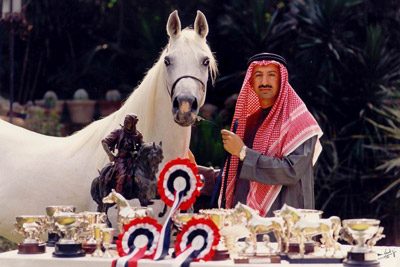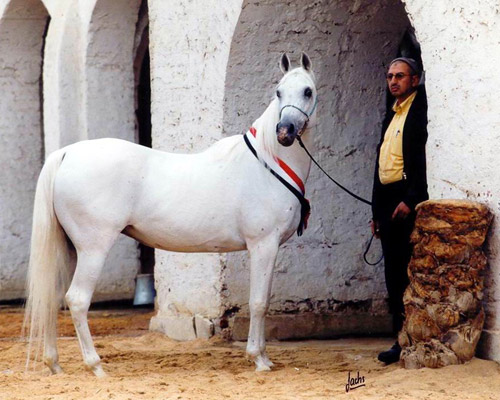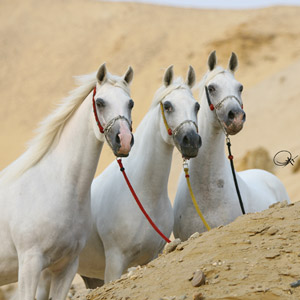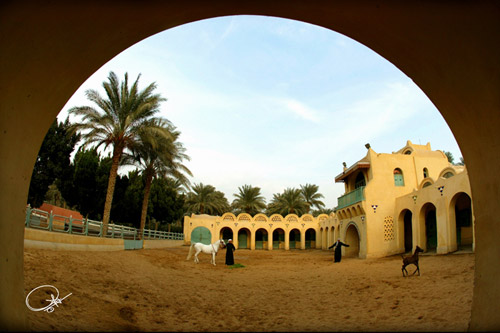|
Rabab Stud came to life in the early
1980’s as the beginnings of a dream for Khaled bin Laden. As with many
Arabian horse breeders, it all began as a fascination with the Arabian
and a strong interest in its beauty, character, spirit and of course,
its history. As a rider, he was primarily interested in athletic
ability. However, one day he saw an Alaa el Din daughter, named Rabab
and determined that he would buy land near the desert and begin to
breed Arabians.
 Since
then, the farm has been in a constant process of evolving and
enlarging its program. Today, Rabab Stud is situated on a lush green
land with paddocks nestled amidst date palm groves and brightly
flowering cactus plants right at the edge of the desert near the
pyramids of ancient Egypt. The stables are built in a gentle Arab
style with domes surmounting wide aisled rows of stalls. Air and light
freely circulate as the horses thrive in natural surroundings. Since
then, the farm has been in a constant process of evolving and
enlarging its program. Today, Rabab Stud is situated on a lush green
land with paddocks nestled amidst date palm groves and brightly
flowering cactus plants right at the edge of the desert near the
pyramids of ancient Egypt. The stables are built in a gentle Arab
style with domes surmounting wide aisled rows of stalls. Air and light
freely circulate as the horses thrive in natural surroundings.
Khaled’s early years in breeding involved studying the
various lines and learning what he wanted to stress in his breeding.
Much of this time was spent with Mm. Wegdan El Barbary whose Shams El
Asil farm contributed so much to Rabab’s initial program with the get
of Bilal and Misk as well as Ibn Adaweya who is still a major force at
the stud.
 As his program has developed, Khaled has shown a great passion for
bringing in horses and lines which he believes will add to developing
the Rabab horse. As will be evident in the pedigrees shown with the
horses, it has become a serious quest. The overall program has several
avenues which are blending to create the horses he wants. As his program has developed, Khaled has shown a great passion for
bringing in horses and lines which he believes will add to developing
the Rabab horse. As will be evident in the pedigrees shown with the
horses, it has become a serious quest. The overall program has several
avenues which are blending to create the horses he wants.
One of the major areas is a determination to breed midnight black
horses that are extraordinarily beautiful as well as being strong in
conformation.
Khaled is bringing back to Egypt some of the great lines which were
not available for a number of years and breeding them to his horses of
EAO origins. His son, Salem is heavily involved in the operation and
is focusing on the athletic abilities of the Arabian as well as the
beauty. Specifically, he has won the Dancing Horse Championship three
years at the EAO on horses that he has trained.
In addition to
the extensive breeding program, a full Equestrian Center has been
built which is scheduling show jumping and dressage competitions as
well as expanding the philosophy that horses are meant to be enjoyed
and ridden which contributes to their overall condition and
conformation.

Sheikh Khaled
compares breeding to art and music. “I am trying to create a symphony
with the horse”, he says. “It is like a composition where you take
elements from many sources to form a piece of living art that must be
harmonious. One of the older breeders here in Egypt once said that the
Arabian horse is a moving tableau.” Those sentiments are in great
evidence as one walks around the paddocks and through the stables and
enjoys the elegance and spirit of the Arabian horse in a
surrounding that does it justice.
|




